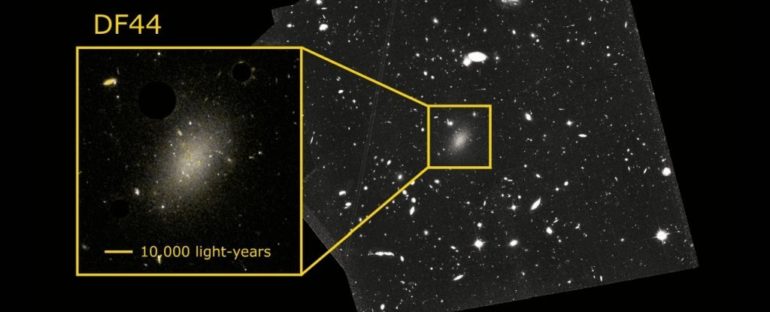The mystery of a galaxy that shouldn’t have existed could now have a solution. Dragonfly 44, a faint galaxy that was found in 2016 to consist of 99.99 percent dark matter, has been closely re-examined, revealing a lower and more normal proportion of dark matter.
This would mean that we don’t have to revise our models of galaxy formation to try to figure out how they could have produced such an extreme outlier – everything is behaving completely normally, the researchers said.
“Dragonfly 44 (DF44) has been an anomaly all these years that could not be explained with the existing galaxy formation models,” said astronomer Teymoor Saifollahi of the Kapteyn Astronomical Institute in the Netherlands.
“Now we know that the previous results were wrong and that DF44 is not extraordinary. It is time to move on.”
Dark matter is a real dilly of a cosmic pickle. We don’t know what it is. We can’t detect it directly, since it does not absorb, reflect, or emit any electromagnetic radiation. But, based on the way some things move around due to gravity – the rotation of galaxies, the way the path of light bends – we can tell how much mass there is in galaxies. And there’s way more mass than can be accounted for in a census of normal, detectable matter.
We call that missing mass dark matter. According to multiple measurements, roughly 85 percent of the matter in the Universe is dark, although proportions in galaxies vary according to the type.
And it’s a key component of our best galaxy formation models. It’s believed that a dark matter network could have channelled matter into galaxies in the early Universe, and that it’s the cosmic glue that holds galaxies together.
DF44, located around 330 million light-years away in the Coma Cluster of galaxies, is of a type known as an ultra-diffuse galaxy. It’s much less bright than the Milky Way; its luminosity suggests that DF44 has 1,000 times fewer stars than our home galaxy.
This made that 2016 measurement of its mass surprising. Astronomers led by astronomer Pieter van Dokkum of Yale University counted the number of globular clusters around DF44, densely packed spherical groups of stars orbiting the galactic centre.
Since the number of globular clusters is linked to the mass of a galaxy (although we’re not sure why), this allowed astronomers to calculate DF44’s mass – and they found that it was almost as massive as the Milky Way.
Given the low number of stars in DF44, this implied that the galaxy almost entirely consisted of dark matter, making it an extreme outlier. Possibly too extreme.
Thus, Saifollahi and his team undertook a globular cluster recount, using the same Hubble Space Telescope observation data as the earlier study. They applied strict parameters for determining which globular clusters are bound to DF44, and ultimately came out with a much lower number.
“The fact that in our work we found only 20 globular clusters, compared with the 80 previously claimed, reduces drastically the amount of dark matter which the galaxy is believed to contain,” said astrophysicist Ignacio Trujillo of the Instituto de Astrofísica de Canarias in the Canary Islands.
“Moreover, with the number of globular clusters we found, the amount of dark matter in Dragonfly 44 is in agreement with what is expected for this type of galaxy. The ratio of visible to dark matter is no longer 1 in 10,000 but one in 300.”
This is not Trujillo’s first run-in with ultra-diffuse galaxies with anomalous dark matter content. Last year, he found that two such galaxies named DF2 and DF4 previously found (also by van Dokkum and colleagues) to have little to no dark matter were also likely normal. The low dark matter measurement was due to a miscalculation of the distance. Revise the distance, and the two galaxies are no longer cosmic freaks.
It is, he told ScienceAlert at the time, much more likely that humans have made an error than that we have found extreme outliers that defy cosmological models. And this is what Saifollai and his team have found this time, too.
“Our work shows that this galaxy is not so singular nor unexpected,” said astrophysicist Michael Beasley of the Instituto de Astrofísica de Canarias. “That way the models of galaxy formation can explain it without the need for modification.”
But the show isn’t necessarily over. Following Trujillo’s distance recalculations, Van Dokkum and colleagues also recalculated the distances to DF2 and DF4. These new analyses obtained results consistent with the team’s initial finding, so we expect the debate around DF44 to be similarly ongoing.
Such debates, however, are good for science. Whatever the results may be, trying to figure it out will help us refine our techniques for studying the cosmos. We’d call that a net win.
The research has been published in The Monthly Notices of the Royal Astronomical Society.



